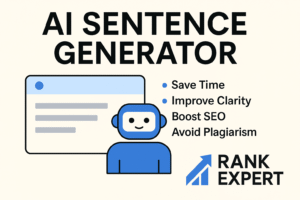Keyword research is the backbone of any successful SEO strategy. Whether you’re launching a new website, optimizing existing content, or scaling your content marketing efforts, understanding how to find and target the right keywords can make or break your visibility on search engines.
In this comprehensive guide, we’ll walk you through the entire keyword research process—from initial discovery to implementation—so you can create content that ranks, converts, and drives long-term traffic.
Why Keyword Research Matters for SEO
Search engines like Google rely on relevance, intent, and authority to rank content. Keyword research helps you understand:
- What your target audience is searching for
- How competitive those search terms are
- What content already ranks (and why)
By identifying high-intent keywords that match your business goals, you can attract more qualified traffic and improve your search engine rankings organically.
Step 1: Define Your Goals and Target Audience
Before you dive into tools and data, clarify:
- Who your audience is
- What products or services you offer
- What problems your audience is trying to solve
Buyer personas, search intent, and content marketing goals all influence the types of keywords you should target.
Step 2: Brainstorm Seed Keywords
Start with a list of core topics or “seed keywords” related to your niche. For example, if you run a fitness blog, your seed keywords might be:
- “home workouts”
- “weight loss tips”
- “muscle gain diet”
Use your seed list to generate long-tail keyword variations. These are longer, more specific phrases with lower competition and higher conversion rates.
LSI Keywords to Include: keyword strategy, SEO research tools, long-tail keywords, keyword intent
Step 3: Use Keyword Research Tools
Leverage keyword research tools to expand your list, analyze volume, and measure competition. Some of the most popular SEO research tools include:
- Google Keyword Planner
- Semrush
- Ahrefs
- Ubersuggest
- Moz Keyword Explorer
- AnswerThePublic
These tools help you discover search trends, keyword difficulty (KD), and search volume metrics to guide your SEO planning.
Step 4: Analyze Search Intent
Understanding keyword intent is crucial. Search intent falls into four main categories:
- Informational – Users are looking to learn (e.g., “how to do keyword research”)
- Navigational – Users are looking for a specific website or brand
- Transactional – Users are ready to make a purchase
- Commercial Investigation – Users are comparing before purchasing
Match your content format (blog, guide, product page) to the keyword’s intent.
Step 5: Evaluate Keyword Metrics
Not all keywords are worth targeting. Evaluate them based on:
- Search Volume: How often the keyword is searched
- Keyword Difficulty: How hard it is to rank
- Cost Per Click (CPC): Indicator of commercial value
- Trends: Seasonal vs evergreen interest
Look for a balance between high search volume and low competition—especially if your site is new.
LSI Keywords to Include: keyword competition, CPC value, SEO difficulty score, organic keyword opportunities
Step 6: Analyze Competitors
Study the top-ranking pages for your target keywords:
- What types of content do they publish?
- How long is their content?
- What keywords are they ranking for?
- What’s their domain authority?
Use competitor keyword analysis to find content gaps and backlink opportunities. Tools like Ahrefs and Semrush are excellent for this step.
Step 7: Group Keywords by Topic Clusters
Modern SEO favors topic clusters over isolated keywords. Group related keywords under broader themes. For example:
Topic: Keyword Research
Clustered Keywords:
- keyword research tools
- how to find keywords
- SEO keyword tips
- best keywords for beginners
Create pillar pages and interlink supporting content to boost SEO performance.
Step 8: Prioritize and Plan Your Content
Once you’ve finalized your keyword list, organize it into a content calendar:
- High-priority keywords = articles or landing pages
- Low-volume but high-conversion = blog posts or FAQs
- Evergreen keywords = long-term content investments
Use content mapping to align keywords with stages of the buyer’s journey: Awareness, Consideration, and Decision.
LSI Keywords to Include: content calendar, topic clusters, keyword mapping, content strategy
Step 9: Monitor and Update Your Keywords
Keyword trends change over time. Use Google Search Console, Semrush, or Ahrefs to monitor your:
- Ranking changes
- CTR (Click-Through Rate)
- Organic impressions
- Keyword cannibalization
Regularly update your content with fresh keywords and optimize based on performance data.
Final Thoughts: From Research to Results
Knowing how to do keyword research for SEO—from start to finish—is a skill that drives long-term growth. When done correctly, it allows you to:
- Understand your audience
- Create content that answers real questions
- Beat competitors in the SERPs
- Improve site authority over time
Remember, keyword research isn’t a one-time task—it’s an ongoing process that fuels your SEO content strategy.
FAQs
What is keyword research in SEO?
Keyword research is the process of identifying the terms and phrases people type into search engines to find content, products, or services. It helps you understand search demand and create content that aligns with user intent.
What is a good keyword difficulty score?
A good keyword difficulty score depends on your domain authority. For new sites, aim for keywords with a difficulty score under 30. More established sites can target keywords with higher competition.
What’s the difference between short-tail and long-tail keywords?
Short-tail keywords are broad and highly competitive (e.g., “SEO”). Long-tail keywords are more specific and often less competitive (e.g., “how to do keyword research for SEO”).
Want Help with Your Keyword Strategy?
If you’re serious about improving your search visibility, get in touch with our SEO team today. We offer keyword research, content strategy, and full-service SEO tailored to your niche.



